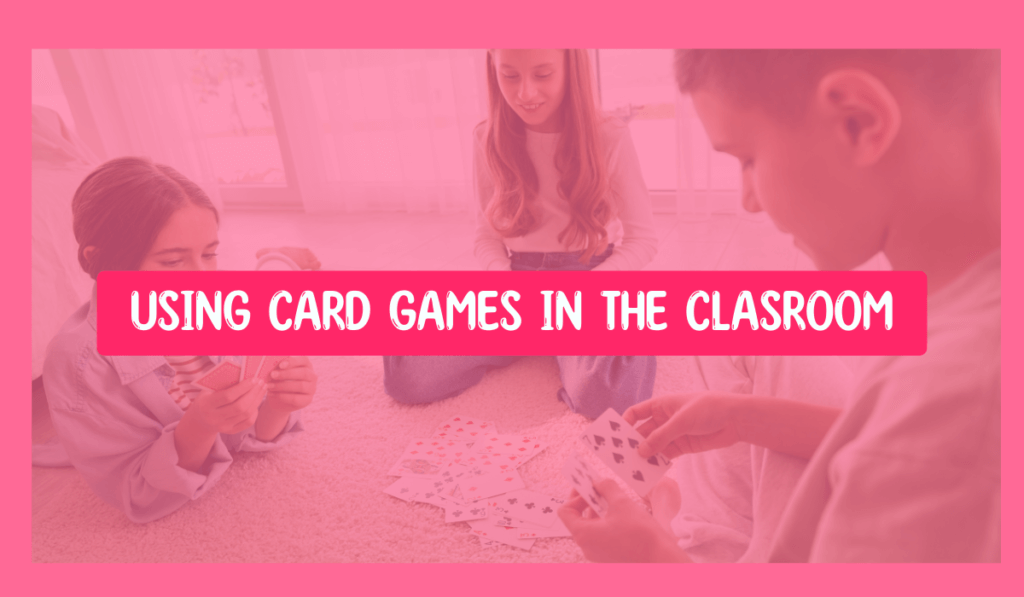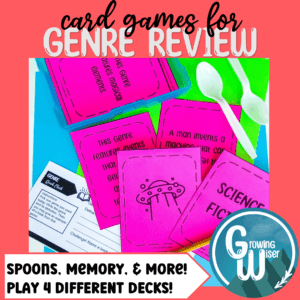
How to Use Card Games in the Classroom
Make Games a Review Routine!
Finding an engaging way to practice word work can be difficult in upper elementary and middle school. Of course, the easy solution is to game-ify it! When it comes to making learning engaging, active, and fun, I’ve found card games to be a great option. Kids love card games, so why not include cards in the classroom? You can even find a game they’re already familiar with and just sprinkle some content into it. For my students, Spoons was the game of choice – so that was my starting point to integrate games into our learning!
Spoons!
For those of you who don’t know what Spoons is: it’s normally played with a regular deck of cards. You sit in a group and deal out 4 cards to each player and set out plastic spoons in the center of the circle, making sure to have one fewer spoon than the amount of players. Then, the dealer picks up one card from the remaining ones, and discards a card to his or her left. The goal is to get a set of four matching cards. The first person who does this grabs a spoon from the middle. Ideally, this is done sneakily. Usually, it leads to chaos. Once one person has grabbed a spoon, the rest are fair game whether you have a set of four or not. There are versions of the game where the person left spoonless is out, or where that person adds a letter to spell “SPOON” each time they miss it. I always find the game fun enough without that addition.
Make it Educational
 Of course, converting this to an educational game takes some thought. My very first attempt was to do a genre matching game. It was…not as smooth as I’d hoped. My first mistake was my love of writing (or unfortunate wordiness as some might put it). I thought a good set of four could be: genre, definition, synopsis, and an excerpt. The latter two were what tripped me up. The first set of cards I made I got somewhat carried away with the synopses and excerpts. When I finally set up my students to play, I noticed the amount of time it took them to read some cards was slowing the game down to the point of benign unfun. Not only that, but the game urgency didn’t balance with the amount of working memory it took to read the cards in their entirety and compare them to the rest of the cards in hand. Oof.
Of course, converting this to an educational game takes some thought. My very first attempt was to do a genre matching game. It was…not as smooth as I’d hoped. My first mistake was my love of writing (or unfortunate wordiness as some might put it). I thought a good set of four could be: genre, definition, synopsis, and an excerpt. The latter two were what tripped me up. The first set of cards I made I got somewhat carried away with the synopses and excerpts. When I finally set up my students to play, I noticed the amount of time it took them to read some cards was slowing the game down to the point of benign unfun. Not only that, but the game urgency didn’t balance with the amount of working memory it took to read the cards in their entirety and compare them to the rest of the cards in hand. Oof.
Back to the drawing board it was. I wanted to rethink it so I could use something easier to glance at. The goal was to maintain the speed and fun of the game after all. Enter roots. By 4th, 5th, and 6th grade, Greek and Latin root recognition has become the biggest hurdle to reading comprehension. We are beyond the stage of basic phonics, but still working on word parts. Of course, there are so very many roots that letting students practice them all can be a bit of a beast. Enter the card game! Here I had the idea to set them up as such: root, definition, example word, and an image. I liked the image because it could open the door for some interpretation and lateral thinking, but was still quick to look at. The other great thing was that, once I had all the cards created, I could mix and match to create vastly different sets.
Teach it Once - Use it Again!
Having one deck completed opened more opportunities. Like a regular deck of 52 cards, I found multiple games could be played. A quick one to go to is “Memory”: the classic grid-based game where you flip cards over to try to match pairs. Of course, the cards also work great for flashcards. What to do with those awkward 5 extra minutes at the end of a class? Grab the deck and play a quick game of around-the-world!
Ready to try out the game in your own class? Sign up to my email list to grab a free Vocabulary version (students get to fill these in themselves!) or head to my store here for a variety of games working on roots, affixes, genre, and more!
